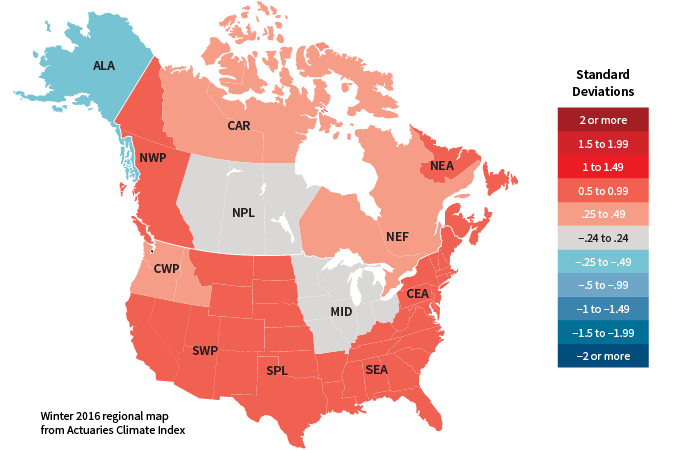Analyzing Extreme Weather
New updates to the Actuaries Climate Index April/May 2017Several actuarial organizations, including the Society of Actuaries (SOA), released new updates for the Actuaries Climate Index. This index provides objective, quarterly measures of changes in extreme weather frequency and sea level. While the index officially launched in November 2016, we now have data updated through spring and summer 2016. In fact, the Actuaries Climate Index value for the United States and Canada for summer 2016 was 1.72, the third-highest seasonal level recorded.

Good Research Reads
Sightlines Project on Longer Lives
The Society of Actuaries (SOA) helped fund research for the Stanford Center on Longevity’s Sightlines Project, an effort focusing on healthy living, financial security and social engagement. Access highlights of the report and recent media coverage.
Proposed Cancer Claim Cost Valuation Tables
The joint American Academy of Actuaries (the Academy) and SOA Cancer Claims Cost Tables Work Group released a report of proposed new cancer valuation tables for cancer policies. Access the proposed tables, report and experience information.
New Report on Actuarial Modeling Governance
The SOA Modeling Section and Financial Reporting Section released a report on actuarial modeling governance, updating a previous study on modeling controls for U.S. and Canadian life insurance companies. The report provides an industry assessment and proposes considerations for enhancing the current state toward a well-controlled governance framework.
By way of background, the Actuaries Climate Index was developed by the Climate Change Committee, formed from a partnership among the American Academy of Actuaries (the Academy), the Canadian Institute of Actuaries (CIA), the Casualty Actuarial Society (CAS) and the SOA. The index is designed to provide actuaries, public policymakers and the general public with objective data about changes in the frequency of extreme climate events over recent decades.
I encourage you to visit the website and examine the data analysis available. You can look at specific regions within North America and a variety of time frames by adjusting the parameters. For example, you can investigate high and low temperatures, find out the data on extreme wind power, and dive deeper into heavy precipitation and drought. Aside from the separate regional data analysis, we provide an overall Actuaries Climate Index average using the six different index components with data from 1961 to summer 2016. The current five-year moving average of the index is 1.03, which continues a trend of exceeding observations from the 30-year reference period from 1961–1990.
The current highest five-year average values by region are in:
- Northwest Pacific (British Columbia and Yukon Territory)
- Northeast Atlantic (New Brunswick, Newfoundland and Labrador, Nova Scotia and Prince Edward Island)
- Southern Plains (Kansas, Montana, North Dakota, Nebraska, Oklahoma, South Dakota, Texas and Wyoming)
High temperatures and rising sea levels primarily drive the high values in these regions. We will continue to provide quarterly updates, using data for each meteorological season when available.
The next phase of this project will build on the initial climate variable research and develop the Actuaries Climate Risk Index. This second index will measure correlations between changes in the frequency of extreme events as measured by the index and insurance variables, such as economic losses, mortality and injuries. Stay tuned for more updates from the sponsoring actuarial organizations.

